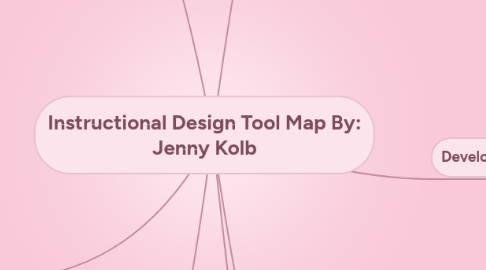
1. Analysis
1.1. Task Analysis
1.1.1. Does this involve an action?
1.1.2. Do I know how to complete the action?
1.1.3. What steps need to be taken to complete this task?
1.1.4. What materials do I need to complete this task?
1.2. Learner Analysis
1.2.1. Demographics
1.2.2. Accomodations
1.2.3. ELLs
1.2.4. Home life/ personal life
1.2.5. Interests of students
1.2.6. Cultural Relevance
1.3. Content Analysis
1.3.1. Research (textbooks, internet, etc.)
1.3.2. Organization
1.3.3. Approach to content
1.3.4. Standards
1.4. Context Analysis
1.4.1. Demographics of School
1.4.2. Funding/Policies
1.4.3. Materials
1.4.4. Technology
1.4.5. School Culture
1.5. Steps for Analysis
1.5.1. What do I know?
1.5.2. What do I need to research?
1.5.3. How do I fill in the gaps for my research?
1.5.4. What is the sequence for all of this information?
2. Understanding by Design
2.1. Desired Results
2.1.1. Transfer goal
2.1.2. Essential question
2.1.3. "meaning"
2.1.4. knowledge & skill
2.2. Evidence
2.2.1. Performance Tasks
2.2.1.1. GRASPS
2.2.1.1.1. Goal
2.2.1.1.2. Role
2.2.1.1.3. Audience
2.2.1.1.4. Situation
2.2.1.1.5. Perfrormance
2.3. Learning Plan
3. Universal Design for Leaning
3.1. Rpresentation
3.1.1. options for perception
3.1.2. Options for mathematical, language expressions,
3.1.3. Options for comprehension
3.2. Action and Expresssion
3.2.1. Provide options for physical learning
3.2.2. Provide options for expression and communication
3.2.3. Provide options for executive functions
3.3. Engagement
3.3.1. Provide options for recruiting interest
3.3.2. Provide options for sustaining effort
3.3.3. Provide options for self- regulation
3.4. Making sure every learner has the same options and has an equal opportunity to learn
3.5. Differentiation
3.5.1. Content
3.5.2. Process
3.5.3. Product
3.5.4. Environment
4. Design
4.1. Three Domains of Learning
4.1.1. Cognitive
4.1.2. Affective
4.1.3. Psychomotor
4.2. Qualities of Clear Objectives
4.2.1. Clear
4.2.2. Communicates what students should learn
4.3. Type of Objectives
4.3.1. Terminal Objectives- What Student should know at the end
4.3.2. Enabling Objectives- Component skills
4.4. ABCD Objective Writing
4.4.1. A- Audience
4.4.1.1. Who are your learners?
4.4.2. B- Behavior
4.4.2.1. What is the student supposed to do?
4.4.3. C- Condition
4.4.3.1. Circumstances under which the student has to perform
4.4.4. D- Degree
4.4.4.1. How well do they have to do the task under the condition?
4.5. Enduring Understandings
4.5.1. Two broad concepts with a relationship
4.6. Essential Questions
4.6.1. Supporting Questions
5. Development
5.1. Implementation Plan
5.1.1. Gagne's 9 Stages of Instruction
5.1.1.1. 1.Gain Attention
5.1.1.2. 2. Inform learners of objectives
5.1.1.3. Stimulate recall of prior learning
5.1.1.4. Present the content
5.1.1.4.1. 6 Facts of Understanging
5.1.1.5. Provide Guidance
5.1.1.6. Elicit Performance
5.1.1.7. Provide Feedback
5.1.1.8. Assess Performance
5.1.1.9. Enhance retention and Transfer
5.2. Development Plan
5.3. Plan for Technology
5.4. WHERETO
5.4.1. Where?
5.4.2. Hook
5.4.3. Equip and Experience
5.4.4. Rethink
5.4.5. Evaluate
5.4.6. Tailor
5.4.7. Organize
6. Evaluate
6.1. How Learning objectives will be assessed
6.2. Evaluation Plan
6.2.1. Objectives
6.2.2. Activities
6.2.3. Formative Assessments
6.2.3.1. Rubric
6.2.3.2. Checklist
6.2.4. Summative Assessments
7. Implementation
7.1. Classroom Management
7.1.1. Time management
7.1.2. Transitions

